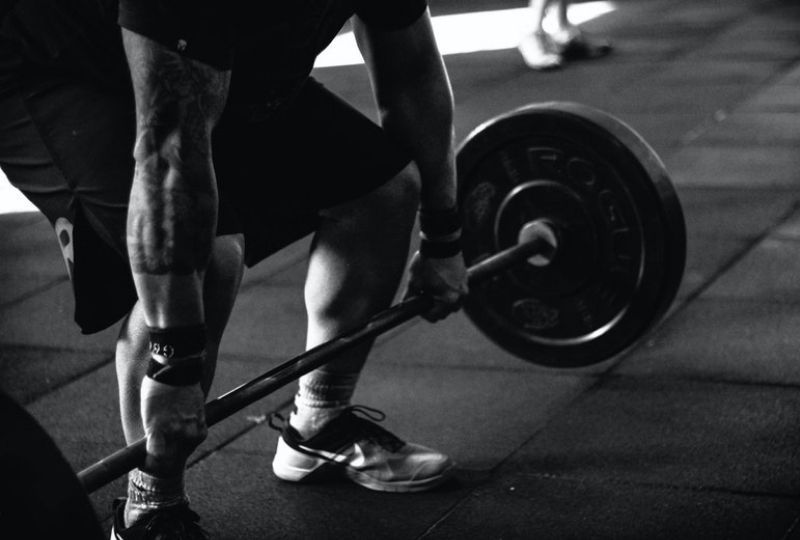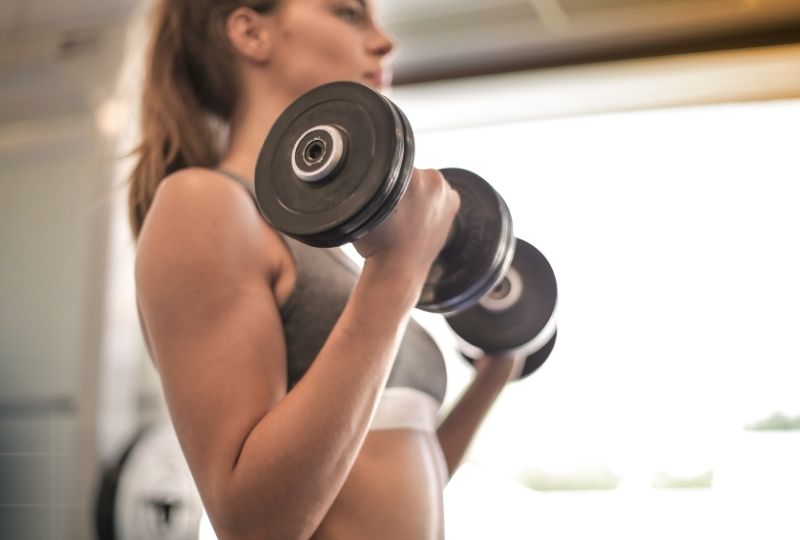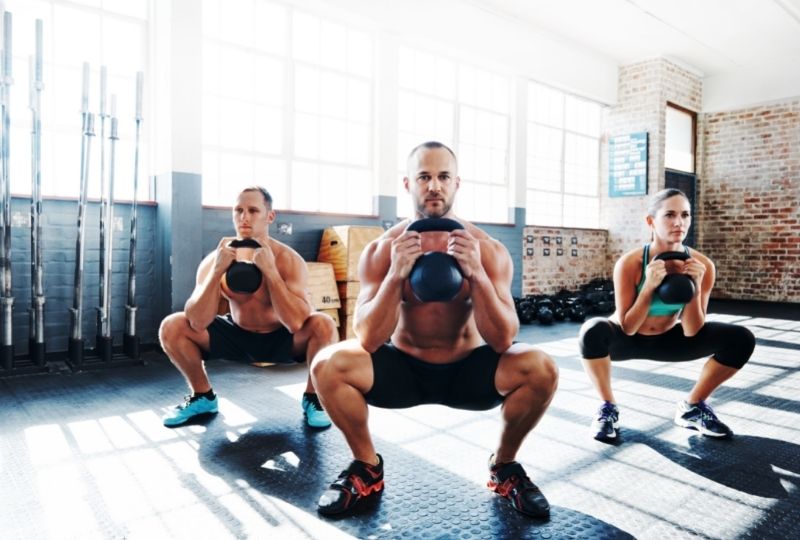What's inside
Whether you’re researching your first-ever weight training program, or just looking to progress from one split to another, there are a million things to consider.
One of the central questions is, how many exercises to do in each workout?
This article is a comprehensive guide addressing just that.
We’ll cover the optimal number of exercises for every muscle group, training goal and workout split.
There are also many example workouts for you to use. These include the best number of exercises like adding muscle mass, gaining super strength, and losing unwanted body fat.
How many exercises per workout session should you do?
Related: Top 10 Exercises & A Full Dumbbell Chest Workout Without Bench
The number of exercises you do per session will depend on your training split and goals.
You may perform 1-2 exercises per muscle group for eight or more exercises for a full-body workout.
However, in a split routine, you may use 3-4 or more exercises for a specific muscle group, with that particular session consisting of fewer total exercises.
To know how many exercises to include in a workout, you also need to consider training principles like individualization.
The following section will break down suggestions for the number of exercises based on specific training goals.
How Many Exercises Per Muscle Group for Hypertrophy / Bodybuilding
Related: How Long Does It Take To Get Ripped
Beginner (1-2 exercises per muscle group)
Many people getting into resistance training for the first time have the primary goal of muscle growth or hypertrophy.
When it comes to a beginner program targeting muscle mass, it is usually best to start simply.
This means that it is usually the better choice wherever there is an option to cover multiple muscle groups with a single exercise.
For example, a chest fly movement will isolate the pectoral muscles, while a chest press movement will recruit the pectorals, anterior deltoids, and triceps.
A good starting program for new lifters is a full-body workout prescribed with muscle growth in mind:
| Exercise | Sets x Reps | Rest |
| Dumbbell chest press | 3×12 | 1 min |
| Supported row | 3×12 | 1 min |
| Horizontal leg press | 3×12 | 1 min |
| Machine shoulder press | 3×12 | 1 min |
| Underhand lat pulldown | 3×12 | 1 min |
After consistently progressing with a program like this three times per week, beginners have many options to step up their training to ensure continued muscle growth.
See the example programs below for ideas on different workout splits for hypertrophy.
The next logical progression for a beginner could be a program like the upper/lower body split or the full-body workout with additional isolation exercises.
Advanced (3-5+ exercises per muscle group)
Related: 12 Battle Rope Exercises
Hypertrophy training requires a higher frequency, volume, and intensity for advanced lifters to continue producing results.
The number of exercises for a given muscle group increases to isolate different areas, providing optimal metabolic conditions to increase muscle size.
For example, while a beginner may only need one good compound press to grow their shoulders, an advanced lifter may need exercises isolating each head of the deltoid:
| Beginner | Advanced |
| Dumbbell shoulder press | Military press |
| Lateral raise (optional) | Machine lateral raise |
| Dumbbell front raise | |
| Rear delt fly | |
| Upright rows |
Because the number of exercises for each muscle group increases considerably, advanced hypertrophy training often consists of different workout splits.
You can see from the example above that increasing the number of exercises from 1-2 to 3-5 per muscle group wouldn’t be realistic in a single session.
One of the most advanced splits is known as the ‘bro split,’ which typically breaks the muscle groups into five separate sessions.
Take a look at the programs below for some examples of advanced hypertrophy splits.
How Many Exercises Per Muscle Group for Strength
Related: What Does PR Mean In The Gym? Track And Set New PRs

Beginner (1-2 exercises per muscle group)
For those new to training, gains in maximal strength will require surprisingly few exercises.
A strength-based program should include multi-joint or compound exercises since maximal force is produced when many muscle groups work together.
While strength is an important attribute for any athlete, sports based predominantly on maximal strength include things like powerlifting.
Powerlifting competitions involve several attempts at a maximal lift in the bench press, barbell squat, and deadlift exercises.
The total weights lifted on the best attempt in each lift are combined for a total score.
For example, a beginner training in powerlifting may produce a total like this (approximately):
- Weight: 145 lbs (65kg)
- Bench Press: 130 lbs (60kg)
- Barbell Squat: 130 lbs (60kg)
- Deadlift: 175 lbs (80kg)
- Total: 440 lbs (200kg)
Olympic weightlifting also relies heavily on strength, adding in the element of speed to create power.
The three powerlifting exercises of the bench press, squat, and deadlift are used because they recruit the most muscle possible, leading to the greatest force output.
In this way, a beginner strength program using just these three exercises would be more than sufficient to produce impressive strength gains.
While most beginners are aware of these exercises, more experienced lifters will know that they are actually quite technical lifts, with many cues to be aware of.
For this reason, more beginner-friendly exercises could be substituted for the ‘big 3’. For example, a beginner strength program could look something like this:
| Exercise | Sets x Reps | Rest |
| Machine chest press | 3×6 | 3 min |
| 45-degree leg press | 3×6 | 3 min |
| Supported row | 3×6 | 3 min |
Performed three times per week with at least one day of rest between sessions, these three exercises alone will produce massive strength gains in a newbie lifter.
Once comfortable with these movements, the next progression would be to advance to the free weight ‘big 3’, start at a reduced weight, and perform the same program structure:
| Exercise | Sets x Reps | Rest |
| Bench press | 3×6 | 3-5 min |
| Barbell squat | 3×6 | 3-5 min |
| Deadlift | 3×6 | 3-5 min |
Advanced (2-3 exercises per muscle group)
For those who’ve been training for a significant amount of time, increasing maximal strength may require more stimulus than for a novice.
While the squat, deadlift, and bench press will still make up the core of an advanced program, there are several ways to add exercises to ensure further strength progression.
First, you may opt to add variations of the ‘big 3’ lifts, such as a dumbbell chest press, front squat, or sumo deadlift.
Another option would be to add additional big compound lifts, such as the military press, bent barbell row, or weighted chin-ups.
Yet another way to include additional exercises in a strength program would be to use accessory exercises to address weak points in your big lifts.
Examples include tricep work, grip strength, core exercises, rotator cuff strengthening, etc.
See the example ‘5×5’ program below for an idea of an excellent maximal strength training regime.
The number of exercises needed can be as little as three, covering all major muscle groups if you just stick to the big lifts.
Start simple, progress consistently and you’ll get an idea of any additional exercise to include in your program as you go.
How Many Exercises Per Muscle Group for Weight Loss

Beginner (1-3 exercises per muscle group)
When losing weight is the main goal, many beginners make the mistake of beginning a resistance training program, thinking it will burn a lot of calories.
During the weight loss process, there are two main roles of your training program.
These maximize the calories burned in the session and preserve as much lean mass (muscle, bone density, connective tissue) as possible.
We need to focus on higher intensity, high-volume exercises that use the most muscle possible for exercise programming.
For the number of exercises, this means a couple for the lower body, a couple for the upper body and more aerobic exercise in the session.
The example workout below will burn calories, provide enough stimulus to preserve muscle mass, and maximize weight loss during your time in the gym:
| Beginner | Sets x Reps | Rest |
| Bodyweight squat | 3×20 | 30 sec |
| Push-ups | 3xMAX | 1 min |
| Walking lunges | 3×20 | 30 sec |
| Inverted row | 3xMAX | 1 min |
| Steady-state cardio | 30-60 mins | – |
Depending on the cardio you choose, you’ll be using multiple muscle groups – if not the entire body.
Running, swimming, rowing, and many other aerobic activities recruit all major muscle groups, meaning you don’t need a bunch of different specific exercises to cover each one individually.
A note here should be given to the role of diet in weight loss – don’t expect the pounds to drop off from working out alone.
Advanced (1-3 exercises per muscle group)
For fitter individuals, a more intense workout may be desired, either to burn more calories in less time or to train the anaerobic energy systems.
Exercises that require work from multiple major muscle groups will create a bigger cardiovascular demand, using more oxygen for energy.
Take a look at this example workout for a high-intensity, fat-burning session:
| Advanced | Sets x Reps | Rest |
| Barbell thruster | 3×15 | 1 min |
| Hang power clean | 3×12 | 1 min |
| Burpees | 3×1 min | 30 sec |
| Pull ups | 3xMAX | 2 min |
| HIIT cardio | 10-20×1 min | 30 sec |
The high-intensity cardio intervals can be done with any full-body aerobic exercise, such as the assault bike, battle ropes, or ski ergometer.
If you want to lose weight but still want to do a proper resistance training program, take a look at the example workouts below, and just make sure to do adequate cardio after or between sessions.
What are the best ranges of sets and reps per workout session?
While the number of exercises is an important consideration for every fitness goal, it is always guided by the training parameters needed for different domains.
This section will provide the exercise prescription guidelines for different targets, which you can then use to determine how many exercises you’ll need to meet the requirements.
Hypertrophy
There is evidence to suggest a significant improvement in muscle growth when performing at least 2-3 working sets of 8-12 repetitions.
Because metabolic stress is the goal, rest breaks should be kept to no longer than 90 seconds.
Strength
The general suggestion for maximal strength development is 3-6 maximal sets of 1-6 repetitions, with long interset rest breaks and 3-5 sessions per week.
Endurance
Endurance can refer to muscular or cardiovascular endurance. When it comes to resistance training for muscular endurance, it is a transition between heavier lifting and aerobic exercise.
Typical rep ranges for endurance training range from 15 repetitions, up to 30 or more.
Of course, this requires significantly lighter weights than are used for hypertrophy or strength training.
Fat Loss

Finally, when training with the sole purpose of losing body fat, parameters like sets and reps are mainly to ensure maximum caloric expenditure and maintenance of lean mass.
Multi-joint exercises and short rest breaks will achieve both of these outcomes.
For convenience, this table provides the parameters for training a muscle group for the four goals mentioned above:
| Goal | Frequency (per muscle) | Sets x Reps | Rest |
| Hypertrophy | 2x per week | 3-4×8-12 | 30-90 sec |
| Strength | 3x per week | 3-6×1-6 | 3-5 min |
| Endurance | 3x per week | 2-3×15-30+ | 30 sec |
| Weight loss | 3-5x per week | 3×12-MAX | 30 sec |
Note that the training frequency is not training sessions per week. It is how many times you should train a particular muscle group.
How many exercises per muscle group for full body?

How many chest exercises per workout?
The chest has the primary functions of shoulder flexion, horizontal flexion, and adduction.
These movements can be adequately trained with progressively heavier weight, with a staple exercise like the bench press.
However, the pectoralis major muscle has multiple heads, with muscle fibers traveling in different directions toward its attachment point on the upper arm.
This means that a chest session may have six or more exercises dedicated to it to hit the muscle from every possible angle and range of motion.
| Minimum (e.g) | Maximum (e.g) |
| Bench press | Flat press |
| Incline press | |
| Decline press | |
| Fly / crossover | |
| Incline fly | |
| Decline crossover |
How many back exercises per workout?
Related: Back and Bicep Workouts
While the back muscles have many roles, their major functions in terms of the upper limb are to extend the shoulder, control the shoulder blades, and extend the spine.
A multi-joint, horizontal pull like the bent-over row will recruit the majority of back muscles in a major way.
The major superficial muscles of the back include the lats, traps, spinal erectors, and several muscles that move the shoulder blades.
A workout aiming to isolate or target each of these muscles can include many individual back exercises.
| Minimum (e.g) | Maximum (e.g) |
| Bent row | Horizontal row |
| Vertical pull | |
| Upper trap | |
| Single-arm pull | |
| Pullover | |
| Back extension |
How many shoulder exercises per workout?
The shoulder is involved in many of the exercises mentioned above.
But a movement that is not included in most chest and back sessions is the one that the largest portion of the shoulder is responsible for.
This movement is shoulder abduction. The large medial head of the deltoid is the prime mover in this action.
Therefore, while the other heads can be worked as accessories to pushing and pulling movements, a single exercise such as the lateral raise can cover the main part of the shoulder.
That being said, many people have the goal of increasing the muscle mass on their shoulders which requires additional isolation exercises at the more advanced level.
In addition, other shoulder movements, such as external rotation, should be included to bulletproof the rotator cuff muscles.
| Minimum (e.g) | Maximum (e.g) |
| Lateral raise | Overhead press |
| Lateral raise | |
| Front raise | |
| Reverse fly | |
| Upright row | |
| Internal / external rotation |
How many leg exercises per workout?
While not everybody may agree with this opinion, many others would attest to the fact that you can build strong, big legs with squats alone.
However because there are dozens of muscles in the upper and lower leg, many exercises can be performed in a complete leg training program.
Particularly when it comes to bodybuilding, the individual muscles of the thigh and lower leg are all targeted in isolation and working together in heavy compound lifts.
For example, the quads can be further isolated down to targeting the medial head, lateral head, and rectus femoris, which also crosses the hip joint.
| Minimum (e.g) | Maximum (e.g) |
| Squat | Squat |
| Deadlift | |
| Lunge | |
| Quad isolation | |
| Hamstring isolation | |
| Glutes isolation | |
| Hip adduction | |
| Calf raise | |
| Anterior tibialis |
How many arm exercises per workout?
Because the muscles of the arm mainly control movement at the elbow, these muscles can be trained alongside the larger muscle groups mentioned above.
It is entirely possible to gain strength, endurance, and even muscle mass in the biceps and triceps without any specific isolation exercises.
But arms are just so damn fun to train! So most people include at least one biceps and triceps exercise in their routines.
There are multiple grips, angles, and equipment with which to target the muscles in different ways for those advanced lifters who really need to isolate these muscles to continue their progress.
| Minimum (e.g) | Maximum (e.g) |
| None! | Close-grip curl |
| Wide-grip curl | |
| Hammer curl | |
| Reverse curl | |
| Overhead tricep extension | |
| Tricep pushdown | |
| Dips | |
| Lying tricep extension | |
| Forearm movements |
How many core exercises per workout?
While it is true that the core musculature is active (or should be) in most free weight activities, the muscles respond in the same way when it comes to hypertrophy.
This is why it might be a good idea to include at least one trunk flexion movement to stimulate the rectus abdominis, or six-pack muscles.
A complete core workout can include multiple exercises to train the several layers of abdominal muscles and their different movements of the torso.
| Minimum (e.g) | Maximum (e.g) |
| Ab crunch | Bosu crunch |
| Hanging leg raise | |
| Bicycle crunch | |
| Side plank | |
| Plank |
Recommended Work Splits and Schedules for Muscle Grouping
Push / Pull / Legs
First up, we have the most popular 3-day workout split, the PPL split.
While named after the joint movement patterns, the PPL essentially splits the muscle groups up as follows:
- Push: Chest, delts, triceps
- Pull: Back, rear delts, biceps, forearms
- Legs: Quads, hamstrings, glutes, calves
Each workout in this example contains five exercises, with each muscle group getting a total of 2-3 exercises.
Some of these are in the form of compound movements where a particular muscle group may not be the prime mover but has an active role.
In these cases, there is always at least one exercise where that muscle is the star of the show.
For example, while the triceps may look like they only have one exercise, remember that they are also stimulated in the incline and shoulder press movements.
Workout:
Push Workout
| Exercise | Sets x Reps | Rest |
| Incline bench press | 4×10 | 1 min |
| Decline cable chest fly | 3×12 | 1 min |
| Dumbbell shoulder press | 3×12 | 1 min |
| Machine lateral raise | 3×12 | 1 min |
| Overhead tricep extension | 3×12 | 1 min |
Pull Workout
| Exercise | Sets x Reps | Rest |
| T-bar row | 4×10 | 1 min |
| Lat pulldown | 3×12 | 1 min |
| Straight-arm pullover | 3×12 | 1 min |
| Reverse dumbbell fly | 3×12 | 1 min |
| EZ bar curl | 3×12 | 1 min |
Legs Workout
| Exercise | Sets x Reps | Rest |
| Leg press | 4×10 | 1 min |
| Sumo deadlift | 4×10 | 1 min |
| Dumbbell side lunge | 3×12 | 1 min |
| Leg extension | 3×12 | 1 min |
| Standing / seated calf raise | 3×12 | 1 min |
Weekly Schedule:
- Monday: Push
- Tuesday: Pull
- Wednesday: Legs
- Thursday: Push
- Friday: Pull
- Saturday: Legs
- Sunday: Rest
Upper Body / Lower Body
Next, we have the upper/lower body split, a popular next step for beginners ready to move on from full-body training.
You’ll notice here that this is one of the longer workouts on this list. This is because there are a lot of muscle groups to cover within the upper body.
One way to look at it is to combine the push and pull sessions from a PPL split workout.
There are no more than eight exercises per session, and the sets total 24 or less, within acceptable ranges for exercise prescription.
This will simply be a program where you’ll want to stick to the rest times and be efficient with your warm-up and cool down to avoid being in the gym for hours on end.
Workout:
Upper Body Workout
| Exercise | Sets x Reps | Rest |
| Dumbbell bench press | 3×10 | 1 min |
| Bent-over row | 3×10 | 1 min |
| Machine chest fly | 3×12 | 1 min |
| Chin-ups | 3xMAX | 3 min |
| Dumbbell lateral raise | 3×12 | 1 min |
| Cable straight-arm pulldown | 3×12 | 1 min |
| EZ bar french press | 3×12 | 1 min |
| Hammer curls | 3×12 | 1 min |
Lower Body Workout
| Exercise | Sets x Reps | Rest |
| Barbell front squat | 3×10 | 1 min |
| Straight-legged deadlift | 3×10 | 1 min |
| Bulgarian split squat | 3×12 | 1 min |
| Adductor / abductor machine | 3×12 | 1 min |
| Single leg calf raise | 3×12 | 1 min |
| Seated calf raise | 3×12 | 1 min |
| Reverse crunch | 3xMAX | 1 min |
| Cable core rotations | 3×12 | 1 min |
Weekly Schedule:
Version 1
- Monday: Upper body
- Tuesday: Lower body
- Wednesday: Rest
- Thursday: Upper body
- Friday: Lower body
- Saturday: Rest
- Sunday: Rest
Version 2
- Monday: Upper body
- Tuesday: Lower body
- Wednesday: Upper body
- Thursday: Lower body
- Friday: Upper body
- Saturday: Lower body
- Sunday: Rest
Full-Body
Next, we have an option for beginners or those who like to hit all their muscles each workout.
This is completely fine with a full-body program, as you have plenty of time to recover between sessions.
Your muscles may get more volume with a program like this than with certain splits.
For example, in the PPL split, the pecs get two exercises twice per week for a total of 14 working sets.
In this full-body program, the same number of exercises with a higher frequency gives the chest 16 working sets over the same one-week period.
While performing this workout three times per week is great for beginner to intermediate lifters, you don’t have to simply stick to the same workout every session.
You could create two similar full-body workouts for three unique sessions while hitting each muscle group with the same weekly volume.
Workout:
| Exercise | Sets x Reps | Rest |
| Incline dumbbell press | 3×10 | 1 min |
| One arm row | 3×12 | 1 min |
| Leg press | 3×10 | 1 min |
| Decline bench press | 3×12 | 1-3 min |
| Cable row | 3×10 | 1-3 min |
| Walking lunges | 3×12 | 1-3 min |
| Cable lateral raise | 3×12 | 1 min |
| Hanging leg raises | 3xMAX | 1-3 min |
Weekly Schedule:
- Monday: Full body
- Tuesday: Rest
- Wednesday: Full body
- Thursday: Rest
- Friday: Full body
- Saturday: Rest
- Sunday: Rest
Arnold Split
Related: Does Flexing Build Muscle?
This classic bodybuilding-style program is modeled after the legend himself, Arnold Schwarzenegger.
Arnold’s classic training splits were chest and back, legs, and shoulders and arms.
However, you’ll see below that the workouts are all in separate tables. This is for a specific reason.
While combining the workouts is more than acceptable, it was common for bodybuilders in the classic era to train twice daily.
This would allow them to bring maximal intensity to each muscle group, rather than losing effort on their last few exercises.
While two trips to the gym in one day won’t work for everyone, for those who want to do what the best of the best did, it’s here for you below.
Another tip for those planning to combine workouts is to consider combining the first leg workout with shoulders and the second one with arms.
If you prefer to work arms and shoulders together, just get ready for one heck of a leg day.
Workout:
Chest + Back Workout
| Exercise | Sets x Reps | Rest |
| Machine chest press | 3×10 | 1-2 min |
| Incline barbell bench press | 3×10 | 1 min |
| Cable decline chest fly | 3×15 | 1 min |
| Cable crossover | 3×15 | 1 min |
| Exercise | Sets x Reps | Rest |
| Barbell row | 3×10 | 1-2 min |
| T-bar row | 3×10 | 1 min |
| Cable row | 3×12 | 1 min |
| Wide-grip lat pulldown | 3×12 | 1 min |
Legs Workout
| Exercise | Sets x Reps | Rest |
| Barbell squat | 3×10 | 3 min |
| Leg press | 3×12 | 1 min |
| Leg extension | 3×15 | 1 min |
| Lying hamstring curl | 3×15 | 1 min |
| Exercise | Sets x Reps | Rest |
| Deadlift | 3×10 | 3 min |
| Side lunges | 3×12 | 1 min |
| Standing calf raise | 3×15 | 1 min |
| Seated calf raise | 3×15 | 1 min |
Shoulders + Arms Workout
| Exercise | Sets x Reps | Rest |
| Overhead press | 3×10 | 3 min |
| Lateral raise | 3×15 | 1 min |
| Dumbbell front raise | 3×15 | 1 min |
| Bent-over reverse fly | 3×15 | 1 min |
| Exercise | Sets x Reps | Rest |
| Barbell curl | 3×10 | 1 min |
| Concentration curl | 3×15 | 1 min |
| Lying tricep extension | 3×10 | 1 min |
| Rope tricep pushdowns | 3×15 | 1 min |
Weekly Schedule:
Version 1
- Monday: Chest and back
- Tuesday: Legs
- Wednesday: Shoulders and arms
- Thursday: Chest and back
- Friday: Legs
- Saturday: Shoulders and arms
- Sunday: Rest
Version 2
- Day 1: Chest and back
- Day 2: Legs
- Day 3: Shoulders and arms
- Day 4: Rest
- Repeat
5×5
Finally, we have one of the best program styles for building pure strength.
The 5×5 program is named simply for the sets and reps performed, which is not the only straightforward aspect.
Each session only contains three exercises for each major movement pattern or muscle group.
The first session contains two of the ‘big 3’ powerlifts, along with one of the best back strength builders, the bent row.
The second workout starts with heavy deadlifts, followed by some overhead lifting and a weighted vertical pull.
These exercises are included for those who want to gain strength in multiple aspects, perhaps building toward the Olympic lifts or more relative strength for calisthenics.
Three exercises might not seem like a lot, but anyone who’s tried 5×5 will attest that it’s a program unlike any other.
The rest breaks are especially important when training for maximal strength, as you’ll need sufficient time for the nervous system to recover to optimally recruit muscle fibers each set.
A different program for sure, but one that comes with a high personal recommendation from having seen amazing results firsthand.
Workout:
Workout A
| Exercise | Sets x Reps | Rest |
| Barbell squat | 5×5 | 3-5 mins |
| Bench press | 5×5 | 3-5 mins |
| Bent row | 5×5 | 3-5 mins |
Workout B
| Exercise | Sets x Reps | Rest |
| Deadlift | 5×5 | 3-5 mins |
| Barbell military press | 5×5 | 3-5 mins |
| Weighted chin up | 5×5 | 3-5 mins |
Weekly Schedule:
Week 1
- Monday: Workout A
- Tuesday: Rest
- Wednesday: Workout B
- Thursday: Rest
- Friday: Workout A
- Saturday: Rest
- Sunday: Rest
Week 2
- Monday: Workout B
- Tuesday: Rest
- Wednesday: Workout A
- Thursday: Rest
- Friday: Workout B
- Saturday: Rest
- Sunday: Rest
Final Thoughts
So, what did you think of our suggestions? We hope this article helped you clarify how many exercises to include in each workout in your program.
In the comments, let us know how many exercises you usually perform in a single workout. You can also tell us if you plan to use some of the advice in this article to reshuffle your exercises for optimal gains.
If you have any training partners or friends that you think could benefit from this information, don’t hesitate to share this article!

